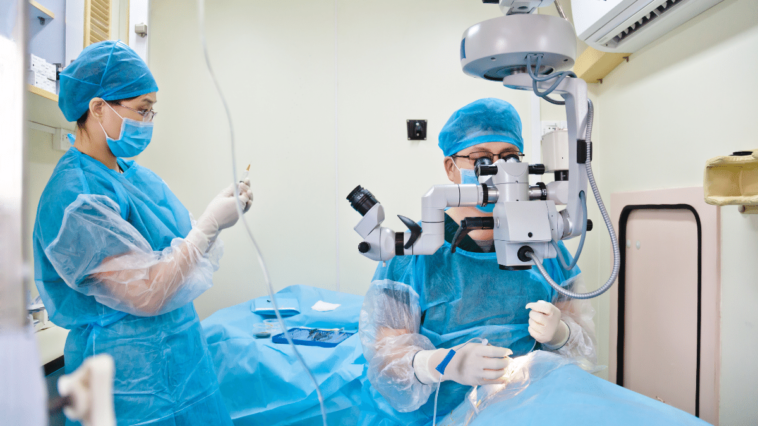What Is An intraocular Lens Implant?
An intraocular Lens Implant (IOL) is an artificial lens, usually made of plastic, that replaces the eye’s natural crystalline lens after it has been surgically removed in cataract surgery.
IOLs are used to restore vision and reduce the dependence of patients on glasses. This surgical procedure involves implanting a new lens in the eye, which can correct refractive errors such as nearsightedness, farsightedness, and astigmatism. The IOL can also be combined with other treatments or technologies to improve visual acuity.
Types of Intraocular Lens Implants
A cataract is a cloudy area that develops in the eye’s natural lens, causing vision loss. To treat cataracts, the cloudy natural lens must be removed and replaced with an artificial lens. Intraocular lens (IOL) implants are a type of artificial lens used to replace the eye’s natural lens during cataract surgery.
IOL implantation is a standard and safe surgical procedure that an ophthalmologist performs. The surgery usually takes about 30 minutes and is performed under local anesthesia. Following surgery, most people can resume their normal activities within a few days.
IOL implants are an effective way to treat cataracts and improve vision. If you are experiencing vision loss due to cataracts, speak with an ophthalmologist about whether IOL implants may be right for you.
There are several different types of intraocular lens (IOL) implants available, including:
- Monofocal IOLs: These lenses correct for distance vision and are typically used to treat cataracts.
- Multifocal IOLs: These lenses correct for distance and near vision, allowing people to see clearly at multiple distances.
- Toric IOLs: These lenses are correct for astigmatism and distance vision. Astigmatism is an eye condition in which the cornea or natural lens of the eye is irregularly shaped, causing distorted vision.
- Accommodating IOLs: These lenses are designed to move slightly within the eye to focus on objects at different distances.
- Phakic IOLs: These lenses are used in people with very high levels of nearsightedness (myopia) and are not candidates for LASIK or other refractive surgery. Phakic IOLs are implanted in front of the eye’s natural lens rather than replacing it.
Your ophthalmologist can help you determine which type of IOL best suits your vision needs and preferences.
The Procedure for Inserting an Intraocular Lens Implant
An intraocular lens (IOL) implant is a surgical procedure to replace the eye’s natural lens with an artificial one. It is used when the natural lens has become cloudy due to cataracts or other similar eye conditions. The clouded lens is taken out, and an artificial IOL replaces it. The procedure must be performed by an ophthalmologist, a medical doctor specializing in eye care.
Here is an overview of the procedure for inserting an IOL implant:
- Preparation: Before the surgery, the patient will be given a local anesthetic to numb the eye and surrounding area. They may also be given a sedative to help them relax.
- Incision: The surgeon will make a small incision in the front of the eye, near the edge of the cornea.
- Removing the natural lens: The surgeon will use specialized instruments to remove the natural lens, which has become cloudy due to cataracts or other conditions.
- Inserting the IOL: The surgeon will then fold the IOL and insert it through the incision into the eye. Once in place, the IOL will unfold and settle into position.
- Closing the incision: The surgeon will close the incision with tiny stitches or other specialized closure methods.
- Recovery: After the procedure, the patient will need to rest and avoid strenuous activities for a few days to allow the eye to heal. They will also need to use eye drops as directed by their doctor to help prevent infection and inflammation.
The procedure for inserting an IOL implant is typically quick and relatively painless. Most people can return to normal activities within a few days of the surgery.
Risk Factors Associated With Intraocular Lens Implant Surgeries
Intraocular lens (IOL) surgery is generally a safe and effective procedure for treating cataracts and other conditions affecting the eye’s natural lens. However, as with any surgery, there are risks associated with IOL surgery.
Some of the risks of IOL surgery include the following:
- Infection: There is a risk of infection after any surgery, including IOL surgery. This risk can be minimized by following your doctor’s instructions for care after the procedure, including taking any prescribed antibiotics and using eye drops as directed.
- Inflammation: Inflammation of the eye and surrounding tissue is another possible complication of IOL surgery. This can usually be treated with eye drops or other medications.
- Bleeding: There is a risk of bleeding during or after the surgery. In most cases, this bleeding is minimal and does not cause any long-term problems.
- Damage to other eye structures: During the procedure, there is a risk of damage to other structures in the eye, such as the cornea or retina. This risk is rare and can usually be corrected with additional surgery or other treatments.
- Unsatisfactory visual acuity: In some cases, the IOL may not provide the desired visual acuity after the surgery. This can usually be corrected with additional surgery or other treatments.
The risks associated with IOL surgery are relatively low, and most people experience good visual outcomes after the procedure. It is essential to discuss the potential risks and benefits of the procedure with your ophthalmologist before deciding whether to undergo IOL surgery.
Postoperative Care After Intraocular Lens Implant Surgery
Intraocular lens (IOL) implant surgery is a relatively quick and straightforward procedure usually performed on an outpatient basis.
After the surgery, the patient will need to rest and avoid strenuous activities for a few days to allow the eye to heal. They will also need to follow their doctor’s instructions for postoperative care to ensure the best possible outcome.
Here are some general guidelines for postoperative care after IOL implant surgery:
- Use eye drops as directed: The patient will need to use eye drops as directed by their eye doctor to help prevent infection and inflammation. They should follow the instructions for administering the eye drops, including washing their hands before and after applying them and avoiding contaminating the dropper tip.
- Avoid rubbing the eye: The patient should avoid rubbing their eye or applying any pressure to it for at least a week after the surgery. This can help prevent complications and ensure proper healing.
- Wear sunglasses: The patient should wear sunglasses when outside to protect their eyes from bright light and wind.
- Avoid strenuous activities: The patient should avoid strenuous activities, such as lifting heavy objects or exercising, for at least a week after the surgery.
- Follow up with the doctor: The patient should follow up with their doctor after the surgery. This may include returning for a checkup a few days after the procedure and again a few weeks later.
Patients must follow their doctor’s instructions for postoperative care after IOL implant surgery to ensure the best possible outcome. They should also contact their doctor if they experience any unusual symptoms or have concerns about recovery.
What Is the Cost of Intraocular Lens Implants?
Intraocular lens (IOL) implants are a popular treatment option for people with cataracts or other conditions that affect the eye’s natural lens. The cost of IOL implants can vary widely depending on several factors,
including the type of IOL used, the procedure’s complexity, and the surgery’s location.
Here are some general factors that can influence the cost of IOL implants:
- Type of IOL: There are several IOLs available, and the cost can vary depending on the chosen type. For example, premium IOLs that provide enhanced vision may be more expensive than standard IOLs.
- The complexity of the procedure: The complexity of the procedure can also affect the cost of IOL implants. Factors that can increase the complexity of the procedure include the presence of other eye conditions, the need for additional procedures, and the patient’s overall health.
- Location of the surgery: The cost of IOL implants can also vary depending on the location of the surgery. For example, the cost may be higher in a large city compared to a smaller town.
- Insurance coverage: Many insurance plans cover at least a portion of the cost of IOL implants. The amount of coverage will depend on the specific plan and any deductibles or co-payments the patient is responsible for.
Overall, the cost of IOL implants can vary widely. It is essential for the patient to discuss the cost with their doctor and to understand any out-of-pocket expenses that they may be responsible for. Financial assistance may be available for those unable to afford the cost of the procedure.
Intraocular Lens Implant Pros and Cons
Intraocular lens (IOL) implants are a popular treatment option for people with cataracts or other conditions that affect the eye’s natural lens. Like any medical procedure, IOL implantation has both potential benefits and drawbacks.
Some potential pros and cons of IOL implants:
Pros:
- Improved vision: One of the main benefits of IOL implants is that they can significantly improve vision. IOL implants can help restore clear vision and reduce the need for contact lenses or eyeglasses for people with cataracts.
- Quick recovery: The procedure for inserting IOL implants is typically quick and relatively painless, and most people can return to their normal activities within a few days of the surgery.
- Long-lasting: IOL implants are designed to be long-lasting, and most people experience good visual outcomes for many years after the procedure.
- Fewer complications: The risks of complications with IOL implants are generally lower than with other cataract surgery, such as traditional lens removal surgery.
Cons:
- Cost: IOL implants can be expensive, and the cost may not be covered by insurance in all cases.
- Risk of complications: As with any surgery, there is a risk of complications with IOL implantation, including infection, inflammation, and damage to other eye structures.
- Limited visual correction: IOL implants may not be able to correct all vision problems, and additional treatment, such as glasses or contact lenses, may still be necessary.
It is essential for the patient to discuss the potential pros and cons of IOL implants with their doctor and to consider their circumstances and goals before deciding whether to undergo the procedure.






